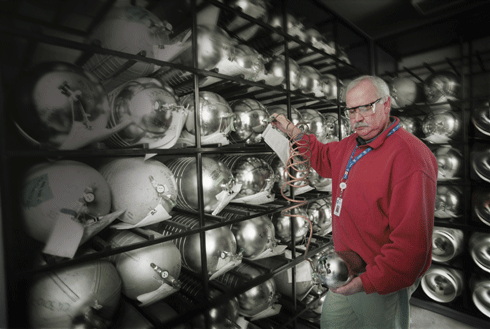
|
Published:
Methane reductions needed urgently
Following a growth spurt that lasted from mid-2006 to mid-2009, the methane emission growth rate is back down to near zero. But the methane problem – a significant contribution to global warming during the industrial period – is not over. Methane levels need to begin falling before we can suggest that things are on the mend.

|
|
Dr Paul Fraser decanting a sample of air taken from Cape Grim in southern Tasmania. Credit: CSIRO
|
Rising global atmospheric methane concentrations, both current and projected, have been of concern for scientists and policy makers because of methane’s high potency as a greenhouse gas. Second in importance to carbon dioxide, methane is responsible for roughly one-fifth of the enhanced greenhouse effect.
Methane levels have largely stopped increasing in the last 10 years. But in 2007, researchers from CSIRO and other global laboratories observed a jump in atmospheric methane concentrations. Extensive research revealed that the faster growth rates were due to enhanced wetland methane release in the Arctic – because of unusually warm summers in 2006 and 2007 – and enhanced wetland emissions in the tropics, a result of unusually wet conditions.
This event is now all but over and the methane growth rate is fast approaching zero again, but as climate change continues, the risk of accelerating growth rates in the future is a real one.
Natural emissions of methane come predominantly from the breakdown of organic matter in wetlands. However, human behaviour has changed atmospheric methane concentrations over the Industrial Age. It is estimated that more than 60 per cent of global methane emissions are human-related (anthropogenic). Of that proportion, livestock accounts for 25 per cent, rice cropping 20 per cent, fossil fuels 25 per cent, landfills 20 per cent, and biomass burning 10 per cent. Geological sources of methane are not influenced by human activity, and comprise only up to about 10 per cent of the total source.
Globally, a reduction in the area of wetlands, due to land clearing and drier conditions, seems to have been balanced by the increase in the release of methane from fossil fuel consumption. Methane is also now considered too precious to waste, so is now being recaptured from fossil fuel extraction processes, for energy production, rather than being wasted by ventilation or flaring.
Pre-industrial methane concentrations were less than half of current concentrations, having risen from about 700 parts per billion (ppb) over 250 years ago to 1795 ppb by early 2010. Current concentrations far exceed the range observed for the past 800 000 years.
In recent years, there have also been concerns about possible methane emission increases from melting of frozen sub-soil (permafrost) in the Arctic and ancient methane hydrates (solidified methane concentrate, also known as ‘clathrates’) underground and in the deep oceans.

|
|
Frozen peatland soil from the Hudson Bay Lowlands, Canada. Credit: Peter Khury
|
Studies measuring isotopes of carbon, conducted by an international team of scientists, including CSIRO, have shown that methane clathrates were not responsible for the large and rapid increase in methane when temperatures rose at the end of the last ice age (12 000 years ago). This is a significant result, because it is evidence that this vast reservoir of methane is more stable during warming than once thought. Likewise, clathrates did not play a role in the recent methane spike.
The situation regarding permafrost is quite different. There is a vast amount of organic matter in the northern circumpolar permafrost region. Arctic temperatures have increased at almost twice the global average rate in the past 100 years resulting in large-scale permafrost thawing. This thawing will expose large amounts of previously frozen organic matter, which decomposes when thawed. In drier conditions the decomposition releases carbon dioxide, while in wetter conditions methane is released.
‘Large amounts of newly exposed organic matter could act as a big compost pile,’ says Pep Canadell, Director of the Global Carbon Project and CSIRO scientist. ‘The microbial activity in this decaying matter can generate the necessary heat to continue thawing permafrost, regardless of future trajectories in human-caused warming.’
In essence, if we warm the planet too much, we face crossing a tipping point that will release vast amounts of both carbon dioxide and methane into our atmosphere.

|
|
Lowland lakes in north-eastern Siberia. Credit: Edward A.G. Schuur
|
As yet, atmospheric methane concentrations have not reached runaway levels (at least, not in the 800 000 year ice core record – there is geological evidence of such events occurring millions of years ago). If we can manage land use, agricultural and fossil fuel emissions we will control concentrations; if we can further reduce the emissions, atmospheric concentrations will actually decline.
Scientists like CSIRO’s Paul Fraser and David Etheridge continue to monitor methane concentrations closely, checking for any unusual changes and their likely cause. However, as Dr Fraser stresses, there is no cause for relaxation – we are not ‘off the hook’.
‘The challenge is to get methane levels back to, or perhaps only half way back to, their pre-industrial levels of 700 ppb. This can only be done by reducing methane emissions – by stopping the gas leaks (mining, landfills, venting) and modifying, where possible, agricultural practices that generate excessive methane,’ Dr Fraser.
‘We need an extended period of reduced methane emissions to start to limit methane’s climate impact.’
More information:
Background on methane,
www.science.org.au/nova/118/118key.html



